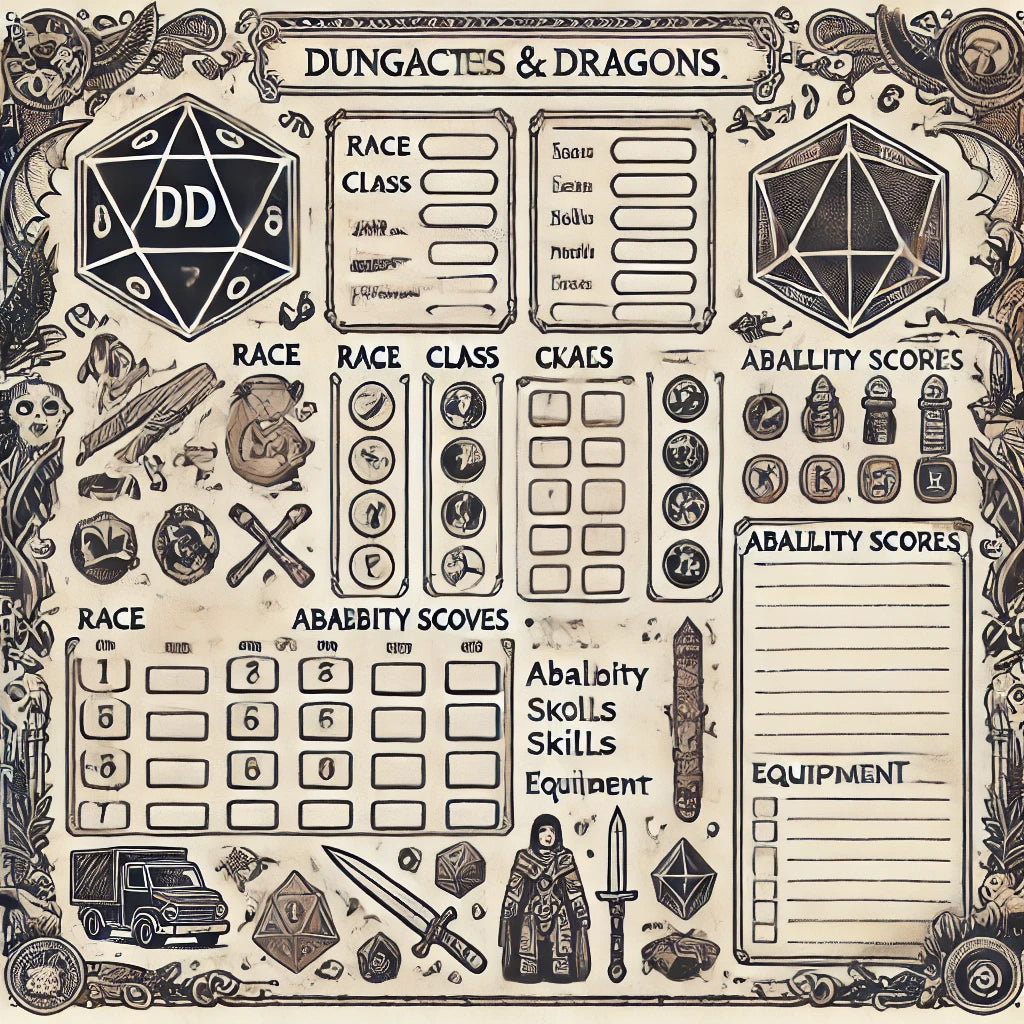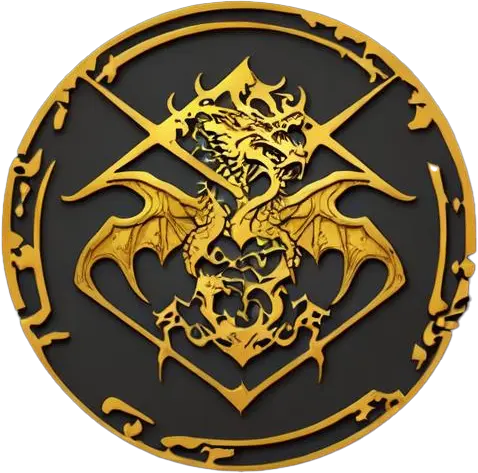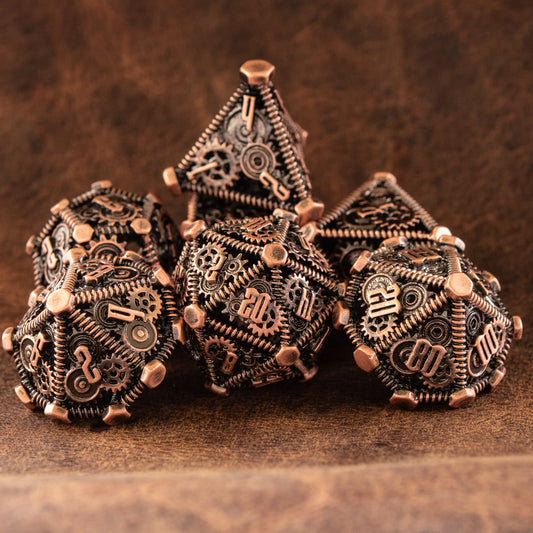
Creating Characters in Dungeons & Dragons (D&D): A Comprehensive Guide
Share
Dungeons & Dragons (D&D) is more than just rolling dice and slaying dragons—it's about crafting unique characters that breathe life into your adventures. Whether you’re new to the game or a seasoned player, creating a D&D character is one of the most exciting and integral parts of the experience. In this guide, we'll explore each step of the character creation process, focusing on how to make your character compelling, mechanically sound, and suited to the story you want to tell.
Table of Contents
- Character Concept: The Heart of Your Hero
- Choosing a Race: The Roots of Your Character
- Selecting a Class: The Core of Your Abilities
- Understanding Ability Scores: Power Through Numbers
- The Role of DnD Dice in Character Creation
- Backgrounds: Shaping Your Past
- Alignment: A Compass for Morality
- Languages, Skills, and Proficiencies: Fine-Tuning Your Character
- Equipment and Starting Gear
- How Your Character Sheet Comes Together
1. Character Concept: The Heart of Your Hero

Every D&D character begins with an idea. Before diving into the mechanics, think about who your character is. Are they a battle-hardened soldier seeking redemption? A mysterious warlock who made a dark pact? A jovial bard with a penchant for storytelling? This concept will guide the decisions you make throughout the process.
Start by answering a few key questions:
- Motivations: What drives your character? What are their goals?
- Personality Traits: How do they interact with others?
- Appearance: What do they look like? How do they carry themselves?
Once you have a rough idea of who your character is, you can begin to flesh out the details by selecting a race and class that fits your concept.
2. Choosing a Race: The Roots of Your Character
In D&D, your character’s race (or species) provides foundational traits such as physical attributes, special abilities, and cultural background. Each race comes with its own set of bonuses and drawbacks that shape your character’s abilities. Some of the most popular races include:
- Human: Versatile and diverse, humans gain an extra feat or ability score increases, making them adaptable to any class.
- Elf: Known for their agility and keen senses, elves excel in Dexterity-based classes like Rangers and Rogues.
- Dwarf: Sturdy and resilient, dwarves are natural fighters, making them great choices for melee classes.
- Tiefling: With infernal heritage, tieflings gain abilities related to magic and fire, perfect for Warlocks and Sorcerers.
Each race also affects your ability scores, something we’ll explore in detail in the next section.
Subraces and Variations
Many races have subraces or variants, like High Elves and Wood Elves, each offering unique bonuses. Take the time to read through these options to see which subrace best aligns with your character concept.
3. Selecting a Class: The Core of Your Abilities
Your character’s class defines what they can do in the world of D&D, from casting spells to swinging swords. Classes are the backbone of any character, determining their skill sets, combat style, and progression over time. Some classic options include:
- Fighter: Masters of combat, Fighters can specialize in many weapons and fighting styles.
- Wizard: Powerful spellcasters, Wizards have access to an extensive spell list and excel in casting offensive and utility spells.
- Rogue: Skilled in stealth and dexterity, Rogues are adept at sneaking, stealing, and delivering high-damage sneak attacks.
- Cleric: Wielders of divine magic, Clerics can heal allies or smite enemies, depending on their deity and domain.
Classes also shape your role in the party. Are you the damage-dealer, healer, or tank? Your class will help define this, so choose one that aligns with your playstyle and character concept.
Multiclassing
Once your character reaches higher levels, you might consider multiclassing, which allows your character to gain abilities from more than one class. This can add complexity and versatility, but it requires careful planning.
4. Understanding Ability Scores: Power Through Numbers
Your character’s abilities are represented by six core ability scores, which reflect their physical and mental aptitudes. These scores range from 3 to 18 and affect everything your character does. The six scores are:
- Strength: Physical power and athleticism. Important for Fighters, Barbarians, and Paladins.
- Dexterity: Agility, balance, and finesse. Critical for Rogues, Rangers, and Monks.
- Constitution: Endurance and health. Key for any class, as it affects hit points.
- Intelligence: Reasoning and memory. Crucial for Wizards and other arcane spellcasters.
- Wisdom: Perception and insight. Important for Clerics, Druids, and Rangers.
- Charisma: Social interaction and leadership. Key for Bards, Sorcerers, and Warlocks.
When creating your character, you'll roll dice (typically 4d6, dropping the lowest die) to determine your ability scores. Alternatively, you can use the point-buy or standard array system to assign scores, giving you more control over your character’s strengths and weaknesses.

5. The Role of DnD Dice in Character Creation
Dice are central to D&D, and nowhere is this more evident than in character creation. Each ability score, attack roll, and saving throw is determined by rolling dice—typically a 20-sided die (d20). The result, combined with your character’s bonuses or penalties, determines success or failure.
For example:
- When rolling for ability scores, as mentioned, you typically roll 4d6 and discard the lowest roll.
- During combat, your attack roll uses a d20, with higher rolls hitting tougher enemies.
- For damage, depending on the weapon or spell, you’ll use various dice like a d4, d6, or d8.
DnD dice sets come in various styles, from classic polyhedral sets made of resin to luxurious metal dice or gemstone dice, which can enhance the tactile experience of gameplay. For many players, collecting different types of DnD dice becomes a hobby in itself.
6. Backgrounds: Shaping Your Past
Every hero has a backstory, and in D&D, this is represented by your character’s background. A background provides additional skill proficiencies, equipment, and role-playing cues that shape how your character interacts with the world. Popular backgrounds include:
- Acolyte: Someone raised in a temple, providing insight into religious institutions.
- Criminal: A rogue with a shady past, ideal for characters with thieving or underworld connections.
- Sailor: Perfect for campaigns set on the seas, granting proficiency in navigating and handling watercraft.
- Noble: Born into a wealthy family, providing advantages in social situations.
Your background often grants additional tool proficiencies (e.g., Thieves' Tools for Criminals) or languages, helping to round out your character.
7. Alignment: A Compass for Morality
Alignment serves as a guideline for your character’s moral compass and worldview, falling into categories like Lawful Good, Chaotic Neutral, or Neutral Evil. Though alignment doesn’t heavily impact mechanics, it can influence your role-playing decisions, such as how your character handles conflict or authority.
Many players opt for Neutral Good or Chaotic Good characters, embodying the ideals of doing what’s right but in their own way. Others might enjoy the challenge of playing Lawful Evil or Chaotic Neutral, balancing self-interest with a code of conduct.
8. Languages, Skills, and Proficiencies: Fine-Tuning Your Character
In addition to race, class, and background, your character will have various skills and proficiencies that define their expertise in specific areas. These can range from being proficient in certain weapons to knowing multiple languages.
- Skills: Skills like Stealth, Persuasion, and Arcana help your character perform specific tasks during gameplay. Each class has a selection of skills they excel in.
- Tool Proficiencies: Whether it's playing a musical instrument or crafting magical items, tool proficiencies add flavor to your character’s abilities.
- Languages: Some races provide extra languages. Elves, for instance, know Elvish, while Dwarves speak Dwarvish. Knowing the right language can unlock certain interactions during a campaign.
9. Equipment and Starting Gear
When creating your character, you’ll choose equipment based on your class and background. Most classes have default starting gear, but you can also roll for starting gold and purchase items manually.
- Weapons: Every class can use specific types of weapons, whether it's a Wizard’s staff or a Fighter’s longsword.
- Armor: Your character's armor class (AC) determines how difficult they are to hit in combat. Heavier armor offers more protection but can limit mobility.
- Adventuring Gear: Essentials like a backpack, rations, and rope can make a big difference during an adventure. Don’t overlook these items when equipping your character.
10. How Your Character Sheet Comes Together
At this point, your character is almost ready to hit the table! The final step is to fill out your character sheet with all the information you’ve gathered. This includes:
- Race and Class Features
- Ability Scores and Modifiers
- Skills and Proficiencies
- Background and Personality Traits
- Spells (if applicable)
Make sure everything is clearly noted on your sheet to avoid confusion during gameplay.
Your character sheet becomes the blueprint for how you navigate the world of Dungeons & Dragons, with each element—from the dice you roll to the decisions you make—reflecting the personality and potential of your character.

